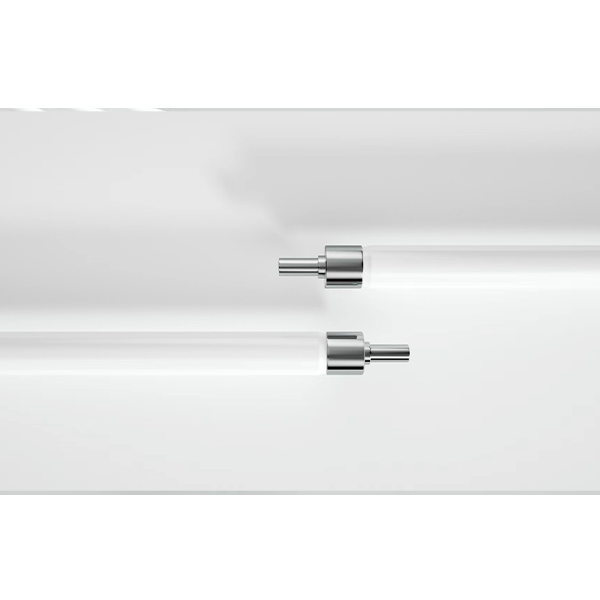Introducing the Fused Silica Ceramic Roller:
- A specialized form of ceramic material that is incredibly pure and clear is fused silica ceramic, sometimes referred to as fused quartz ceramic. It is created from a silica material with a high purity level that is melted and hardened to create a thick, non-crystalline structure. Due to its distinctive production technique, fused silica ceramic has outstanding qualities that make it appropriate for various applications. The Fused Ceramic Roller minimizes material adhesion and sticking due to its smooth, non-porous surface, enabling the smooth and reliable transfer of material.
- This capability is very helpful in situations where exact material handling and homogeneity are essential. Due to its inert nature, it is compatible with various substances and liquids, making it a useful tool in various sectors. Accurate and dependable material conveyance is made possible by the Roller’s exact dimensions and great dimensional stability. Because of its superior wear resistance, surface degradation is minimal, enabling consistent and dependable performance throughout longer service life. As a result, production and efficiency are optimized while downtime and maintenance expenses are reduced. The Fused Roller also offers outstanding chemical resistance. Because of this, it may be used in corrosive or chemically hostile situations.
Considering the Flexibility and Strength of Fused Silica Ceramic:
Fused silica ceramic is a wonderful substance renowned for its adaptability and toughness, sometimes called fused quartz. By rapidly cooling high-purity silica after it has melted at incredibly high temperatures, a glassy form of silicon dioxide (SiO2) is created. The Silica Material is adaptable to individual manufacturing requirements since it comes in sand or powder form. The sand variety is ideally suited for applications that demand shape and structure, such as molding and core-making in foundries. However, the powder form best serves large surface area applications like coatings, fillers, and precision casting. Fused silica ceramic’s remarkable qualities result from its distinctive production technique.

- High-Temperature Resistance:
It can sustain high temperatures without significantly altering its structural integrity. It can function for lengthy periods at temperatures beyond 1,000 degrees Celsius and has a melting point of almost 1,700 degrees Celsius. Due to this, it may be used for high-temperature applications, including laboratory apparatus, aircraft parts, and furnaces.
- Thermal Stability:
Due to its excellent thermal stability. Fused silica ceramics can withstand unexpected temperature fluctuations and thermal stress without cracking or shattering. This property is critical for rapid heating or cooling cycles. Examples include cycles for the production of glass, optical systems and semiconductors.
- Optical Transparency:
High transparency in the ultraviolet, visible and infrared (IR) portions of the electromagnetic spectrum is one of the extraordinary optical properties of fused silica ceramics. It’s great for optics. Includes lenses, windows, prisms, and mirrors used in scientific equipment, lasers, and telecommunications. Because of its minimal light absorption and scattering.
- Mechanical Strength:
Fused silica ceramic has remarkable mechanical strength and hardness despite being a glassy material. It is useful for structural components and as a material for precision moulds, dies, and wafer carriers in the semiconductor production industry because it has a high compressive strength and can sustain mechanical stresses.
- Electrical Insulation:
Which is a superb electrical insulator with a high dielectric strength and a low electrical conductivity? It is often employed in electrical and electronic applications, including insulators, circuit breakers, and high-power electronics, where high-voltage isolation is necessary.
Understanding the Properties and Uses of Fused Silica Ceramic:
Fused quartz is another name for the high-purity non-crystalline form of silica (SiO2) created by carefully melting and cooling silicon dioxide. It has special qualities that make a variety of applications for it possible. Let’s go more into its characteristics and uses:
- High purity:
Ceramics made of fused silica is distinguished by its remarkable purity and low impurity content. The high purity produces excellent optical transmission qualities and chemical resistance.
- High Melting Point:
This material has a high melting point of around 1,700 degrees Celsius, which enables it to tolerate high temperatures without significantly deforming or softening.
- Outstanding Optical Properties:
It is transparent to many wavelengths, from the ultraviolet (UV) to the infrared (IR) regions. It is perfect for various optical applications due to its low absorption and scattering.
- Electrical Insulation:
fused silica ceramic offers strong resistance to the flow of electric current, making it a great electrical insulator.
- Chemical Inertness:
It is chemically inert and is resistant to most acids, alkalis, and other corrosive chemicals. It is appropriate for use in hostile chemical conditions because of this characteristic.
The applications of Fused silica ceramic:
- A consistent particle size distribution is meticulously manufactured into our High Purity Raw Material. Additionally, this guarantees easy handling and stable performance throughout the production process. Additionally, it has good flow characteristics and a low coefficient of thermal expansion, which increase process effectiveness and yield.In optics and laser technology, fused silica ceramics are widely used in optical components. Such as lenses, prisms, windows and mirrors. High-precision optics and laser technology benefit from its strong transmission in the UV, visible and infrared spectrum as well as minimal thermal expansion.
- It is used in the semiconductor industry to create quartz ware, including crucibles, tubes, and boats used to produce integrated circuits. It is a good material for liners, pipelines, and chemical reactors because of its excellent temperature tolerance and chemical inertness. It is employed in those settings when resistance to corrosive substances and high temperatures is necessary.
Conclusion:
A material having a wide variety of uses in several sectors is fused silica ceramic. It consists of silica particles. It has excellent qualities such as high chemical inertness, small thermal expansion, strong thermal shock resistance, and electrical insulation. The design and production of high temperature resistant specific ceramic products for use in heat treatment settings is KAMROLLER area of expertise. The industries of metal processing, glass, construction, semiconductor electronics, automotive, and other fields utilize our high-temperature-resistant ceramic rollers and other ceramic goods extensively.
Post time: 7 月-12-2023
